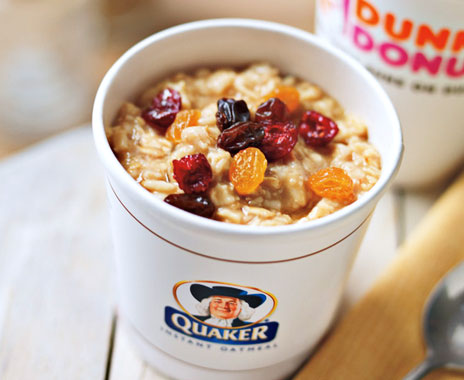In the fast-food breakfast world, the carrier has long been king. From McMuffins to Croissan’wiches, burritos to breakfast wraps, flatbreads to breakfast paninis, and now—thank you, Dunkin’ Donuts—even breakfast sandwiches served on a glazed doughnut, fast-food chains have dedicated an inordinate amount of ingenuity to finding tasty, portable, hand-held ways to deliver the day’s most important meal to us with a minimum of fuss and mess.
This carrier-based approach, it should be said, is a distinctly American way of producing and packaging breakfast fare. Convenience is the driver, and satisfaction in a hurry is the goal. But the carrier-centric orientation stands in stark contrast to the way breakfast is conceived and delivered throughout much of the rest of the world: in a bowl. In China, millions of people break the fast with bowls of congee, or rice porridge; in Japan, it’s often miso broth with such additions as fish, seaweed, and pickled vegetables. Lebanese and Syrian breakfasters may enjoy one of several versions of fatteh, a casserole that combines chunks of pita with eggplant, chickpeas, meats, nuts, and a rich array of sauces, spices, and seasonings. And in parts of Mexico, bowls featuring eggs served on a fried tostada with tomatoes, cheese, vegetables, and beans often help locals gear up for a new day.
So is it time for American quick-serve breakfast to get bowled over? I’ll be frank about my bias. When it comes to menu development, I’m a big fan of what you might call “deconstruction” or “reverse engineering.” Breakfast sandwiches and other hand-held items are delicious, no question. But because these creations essentially compel diners to experience all the constituent parts in every bite, it’s sometimes hard to appreciate the taste and texture of particular ingredients. A bite of an Egg McMuffin, a breakfast burrito, or a croissant egg sandwich can be eminently satisfying, but in each case, the flavors all merge into a seamless whole, which in some ways can diminish the appreciation of what each ingredient contributes to the mix.
For chains interested in exploring new opportunities, I recommend breaking down traditional global breakfast favorites in a way that’s still convenient and portable for on-the-go U.S. consumers. Doing so can create a wealth of new menu possibilities while allowing each individual component to shine. Here are some examples.
For fast-casual Mexican concepts, burrito bowls are nothing new; Chipotle long ago made the tortilla optional. But no major chain I’m aware of has yet perfected a chilaquiles bowl. This sumptuous combination of scrambled eggs, tortilla chips, salsa, cheese, and beans would be challenging to wrap and serve, but it’s a natural for the breakfast-in-a-bowl configuration.
Another Latin-themed option would be to deconstruct pan dulce, or Mexican sweet bread, and transform it into a kind of breakfast bread pudding in a bowl, replete with toppings or baked-in additions, such as fresh or dried fruit, nuts, spices, and so on. And with a little ground corn meal and some terrific barbecued meats, vegetables, and garnishes, a tamale bowl could be an equally novel and delicious menu item.
In the wide world of Asian breakfast cuisine, there are already some interesting bowls in play right outside our door here in the Bay Area. At Plow in San Francisco, the Chinese breakfast incorporates caramelized pork shoulder, two fried eggs, chili paste, and ginger on a bed of jasmine rice. Congee is also becoming increasingly popular in these parts, particularly when flecked with veggies, eggs, and small pieces of chicken and pork. Another celebrated local breakfast and lunch spot, Sweet Maple, offers many creative takes on the traditional eggs Benedict, including an Asian version that combines tofu with sautéed kimchi, green onion, and chipotle hollandaise.
For domestic concepts, Western- and Southern-themed offerings could be just the ticket to some super bowls. Try a take on the classic Hangtown fry in a bowl (minus the oysters, probably!), with eggs on the bottom and bacon or sausage, sautéed potatoes, and scallions on top. Or consider a savory oatmeal of the sort we’re seeing more often around our town these days, with ingredients like mustard and cumin and a fried egg on top. Taking a traditionally sweet hot cereal and transforming it into a delicious savory breakfast could pique consumers’ interest. The formula works well in reverse, too: judging from the almond polenta at Farm:Table, also in San Francisco, a savory staple can go sweet with the addition of almond milk, almond extract, honey, and fresh berries.
It’s possible that some things wouldn’t work brilliantly in a breakfast bowl, but even items as potentially challenging as pancakes, waffles, or French toast could be miniaturized and turned into something easier to eat on the go. While no one is going to retire the traditional breakfast sandwich anytime soon, the deconstructed breakfast could, with a little creativity and investment, make for a compelling counterpart.












